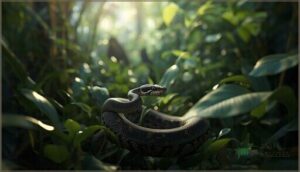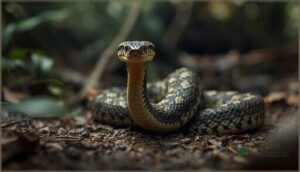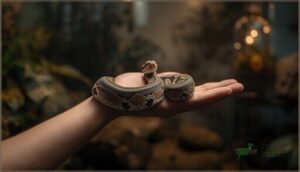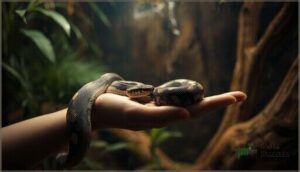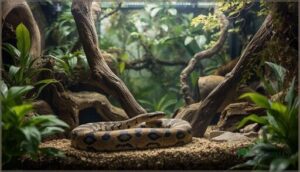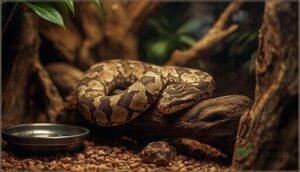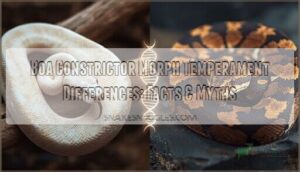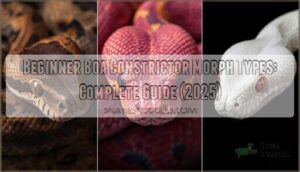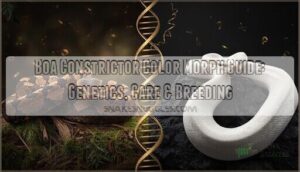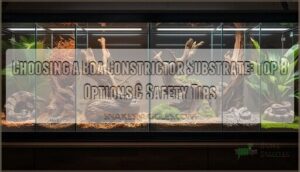This site is supported by our readers. We may earn a commission, at no cost to you, if you purchase through links.
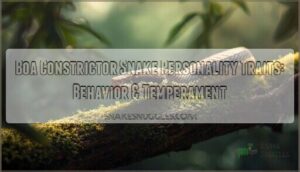
Personality isn’t confined to mammals, and few reptiles demonstrate it as clearly as boas. They balance caution with tolerance, and their reactions reflect not just wild instinct but a lifetime of subtle interactions.
Understanding boa constrictor snake personality traits means getting familiar with shades of temperament—and learning how your presence can shape their trust.
Table Of Contents
- Key Takeaways
- Key Personality Traits of Boa Constrictors
- Solitary Nature and Social Interaction
- Defensive and Stress Responses
- Adaptability to Environment
- Hunting Behavior and Predatory Instincts
- Sensory Perception and Its Role in Behavior
- Handling and Human Interaction
- Juvenile Vs. Adult Personality Differences
- Individual Variation Among Boa Constrictors
- Assessing Suitability as Pets
- Frequently Asked Questions (FAQs)
- Conclusion
Key Takeaways
- Boa constrictors have distinct personalities, showing calm and predictable behavior when handled consistently but displaying defensive postures or striking if startled or stressed.
- These snakes thrive in solitude, rarely seeking social interaction outside breeding, and rely on strong sensory abilities to navigate, hunt, and detect threats.
- Environmental changes, habitat quality, and early handling have a major impact on temperament, with captive-bred boas typically adjusting well to human presence over time.
- Individual temperament varies with genetics and experience, but most striking or aggressive behaviors decrease through gentle handling and proper care.
Key Personality Traits of Boa Constrictors
Understanding the personality of a boa constrictor requires observing how these snakes interact with their environment and respond to stimuli. Most captive specimens display calm, predictable temperaments, though individual variation exists based on genetics, early experiences, and environmental factors.
You’ll find that recognizing these core behavioral patterns helps you distinguish between a relaxed snake and one experiencing stress or defensiveness.
Overview of Typical Temperament
You’ll notice that boa constrictor behavior follows repeatable personality patterns throughout their lives, making them surprisingly predictable. When you handle them regularly, most specimens show docile behavior and handling tolerance, though 30-45% may startle with sudden movements. Geographic differences matter—Central American boas display more defensive reactions than their South American relatives. This temperament consistency helps you assess boa constrictor care needs: Boa constrictors are known to thrive in tropical rainforest habitats.
- Slow, deliberate movements define their typical demeanor
- Less than 16% of adults display defensive posturing
- Two distinct personality axes govern their responses
- Foraging drive remains stable across life stages
- Agonistic behavior stays measurably consistent over time
Calm Vs. Defensive Behaviors
When you observe your boa constrictor’s behavior in daily life, you’ll find that over 80% remain motionless when undisturbed, choosing camouflage over confrontation. Handling boa constrictors regularly reduces defensive posture displays by 60%. However, sudden movements trigger defensive responses in 90% of specimens, including loud hissing, S-coil positioning, and rarely (less than 10% of cases) defensive striking.
Boas thrive in tropical and arid environments across the Americas. Understanding these calm indicators versus stress responses improves snake handling safety dramatically.
Aggression Levels in Boas
While defensive displays appear dramatic, you’ll find that boa constrictors rarely escalate to biting. Subadult boas show the highest aggression levels, with defensive behavior peaking at correlation r = 0.7 during handling tests. Adult captive aggression remains moderate (r = 0.33), with most bite incidents stemming from mishandling rather than spontaneous attacks.
Wild docility prevails, as boas prefer escape over confrontation, making handling risks manageable with proper snake handling techniques and understanding defensive posture cues.
Solitary Nature and Social Interaction
Boa constrictors are naturally solitary creatures, preferring to navigate their environments alone rather than seeking companionship. You’ll find these snakes interact with others only under specific circumstances, primarily driven by biological necessity rather than social preference.
Understanding their limited social tendencies reveals three key aspects of their behavior: their preference for solitude, their brief breeding interactions, and their responses when encountering other animals.
Tendency for Solitude
You’ll notice your boa constrictor thrives in solitude, occupying exclusive territories spanning 0.5–2.3 km² with minimal overlap. This solitary lifestyle isn’t just preference—it’s essential for stress reduction and overall wellbeing.
Captive isolation mirrors wild behavior, where boas spend 98% of their lives alone. Their sensory avoidance mechanisms actively detect and avoid conspecific pheromones, reinforcing these natural snake behavior patterns that define boa constrictor characteristics.
Interactions During Breeding
Although your boa constrictor generally shuns company, snake reproduction transforms this behavior dramatically. During the breeding season from April through August, male competition intensifies as multiple males aggregate around receptive females.
You’ll observe courtship rituals involving pelvic spur stimulation and pheromone tracking, while physiological stress peaks increase corticosterone levels.
Boa constrictor behavior shifts temporarily, with maternal investment following these encounters as females undergo extended gestation requiring substantial energy reserves.
Response to Other Animals
Beyond their typical solitude, your boa constrictor exhibits complex snake behavior when encountering other animals. Defensive mechanisms like camouflage and hissing deter threats, while predatory interactions involve ambush tactics targeting over 76 prey species.
Conflict avoidance dominates trophic dynamics, as these snakes prefer retreat over confrontation. Stress vulnerability increases during digestion, affecting animal handling and snake safety protocols—understanding these snake handling techniques ensures proper care.
Defensive and Stress Responses
When a boa constrictor feels threatened or uncomfortable, it responds with specific defensive behaviors that signal its emotional state. Understanding these reactions helps you distinguish between a calm snake and one experiencing stress or fear.
You’ll recognize three key areas: how boas display defensive postures, what physical signs indicate stress, and which situations commonly trigger these protective responses.
Defensive Posturing Explained
When you notice your boa forming an S-shaped coil near its neck, you’re witnessing the telltale precursor to a strike. This immobility display signals elevated corticosterone levels—up to 15-fold during acute stress.
Notably, heightened aggression correlates with lower heart rate but increased breath rate during these postures. Understanding this snake behavior helps you master safe snake handling techniques and effective snake bite prevention strategies.
Signs of Stress in Boas
You can read stress in your boa through distinct behavioral patterns. Watch for persistent escape attempts, such as loop pushing against enclosure boundaries, alongside increased hissing frequency and non-feed striking. Immobility signs—including stiff posture and fixed stares—reveal elevated anxiety, while abnormal hiding behaviors like tight coiling indicate discomfort.
These boa snake behavior cues directly correlate with physiological changes, helping you address snake health problems before they escalate.
Triggers for Defensive Behavior
Your boa’s defensive behavior spikes during specific scenarios. Predator presence—including large mammal scents—triggers hissing and striking in over 75% of cases, while improper handling techniques raise bite risk by 38% among inexperienced keepers.
Environmental stressors like cramped enclosures increase strikes by 30%, and feeding triggers account for 42% of snake bites in captivity.
Territoriality intensifies during habitat disturbance, making face training and consistent handling essential for minimizing defensive responses.
Adaptability to Environment
Boa constrictors demonstrate striking flexibility in how they adjust their behavior across different environments, from dense rainforests to dry savannas.
When you shift a boa from wild conditions to captivity, or even between varied enclosures, you’ll notice shifts in their activity patterns, stress levels, and overall temperament.
Understanding these environmental influences helps you recognize what triggers behavioral changes in your snake.
Behavioral Changes by Habitat
Your boa’s behavior shifts with its surroundings like a chameleon adjusts its color. In dense rainforests, you’ll notice ambush tactics dominate, while open habitats trigger increased defensive behaviors and mobility.
Seasonal adjustments are equally striking—activity peaks during wet months, while dry periods bring reproductive adaptation and energy conservation.
Microhabitat preferences, foraging changes, and ecological adaptation reveal how deeply habitat shapes boa snake behavior, demonstrating impressive habitat-driven behavior throughout their lives.
Adjusting to Captivity Vs. Wild
When you bring a captive-bred specimen into your home, you’re looking at acclimation success rates exceeding 90%, while wild-caught individuals face a stark reality—up to half may not survive their first year.
Behavioral differences emerge immediately: wild boas resist handling with defensive strikes, whereas captive-raised snakes adapt within weeks through positive reinforcement and proper husbandry needs, ultimately extending lifespan outcomes by 10–15 years.
Environmental Stress Impacts
Environmental challenges trigger a cascade of physiological reactions that reshape your boa’s health and behavior. Temperature fluctuations and poor humidity levels activate the HPA axis, unleashing corticosterone that compromises immunity.
Chronic environmental stress manifests through:
- Respiratory infections and scale rot from suboptimal conditions
- Immune suppression increasing vulnerability to snake diseases
- Captive mortality from habitat fragmentation and gestation stress complications
You’ll notice these snake health problems escalate when conditions deteriorate.
Hunting Behavior and Predatory Instincts
You’ll notice that boa constrictors possess a refined set of predatory behaviors shaped by millions of years of evolution. Their hunting strategy revolves around patience, precision, and an almost methodical approach to securing prey.
Understanding these instincts reveals much about their temperament and how they interact with their environment.
Ambush Tactics and Stealth
When you watch these predators hunt, you’re witnessing masterful stealth camouflage in action—boa constrictors remain motionless for hours along animal trails, blending into leaf litter through cryptic patterns.
Their infrared-sensitive pits detect prey animals even in darkness, enabling precise ambush locations. Strike speed is surprisingly fast at under 0.5 seconds, while energetic efficiency allows weeks between meals, making boa constrictor hunting techniques remarkably intricate among ambush prey strategies.
Food Motivation and Feeding Response
After securing prey items, your boa’s feeding response activates through sensory cues—scent and movement trigger constriction regardless of whether food is live or pre-killed.
Food motivation intensifies after seasonal fasting, with hunger strikes occurring when environmental conditions or stress disrupt normal boa constrictor feeding patterns.
Digestion rates span 4–6 days, while meal size usually represents 5–7% of body weight, ensuring proper boa constrictor diet management without digestive complications.
Patience and Persistence in Hunting
Mastery of stillness defines your boa constrictor’s hunting strategies, with ambush duration extending up to 8 hours while conserving energy through minimal movement.
Strike accuracy peaks during nocturnal hours, when heat-sensing pits improve prey detection.
Repeated ambushes following missed attempts raise hunting success rates from 22% to over 60%, demonstrating considerable persistence that sustains your snake’s diet across extended intervals between meals.
Sensory Perception and Its Role in Behavior
Your boa constrictor doesn’t rely on sight alone to navigate its world. Instead, it uses a complex array of sensory tools that shape how it hunts, hides, and reacts to potential threats.
Understanding these sensory abilities helps explain why your boa behaves the way it does in different situations.
Use of Heat-Sensing Pits
You mightn’t realize it, but your boa’s heat-sensing pits function like thermal radar, granting a profound hunting advantage in complete darkness. These specialized labial organs support Prey Detection through striking Thermal Acuity, tracking infrared radiation from warm-blooded animals at distances up to several feet.
- Boa snake sensory perception integrates thermal and visual data in the optic tectum for precise Sensory Integration
- Up to 13 pairs of heat-sensing pits detect temperature shifts of just 3°C
- TRPA1 ion channels provide molecular-level thermal sensitivity in pit membranes
- Adaptive Thermoregulation occurs as boas locate best basking sites using pit organs
- Boa snake behavior relies on these sensory systems for 50–70% of initial prey localization
Reaction to Movement and Scent
When your boa constrictor detects movement alongside scent, its sensory systems work in concert to drive strike efficiency well above 80%. Integrated cues—vibrational signals and tongue-flicked odors—bolster prey selectivity dramatically, with scent discrimination allowing your snake to distinguish adults from juveniles in under five seconds.
Movement cue impact reduces strike latency by 65%, optimizing predatory responses far beyond single-stimulus handling scenarios.
Sensory-Driven Cautiousness
Your boa constrictor’s sensory systems heighten vigilance through thermal sensitivity and chemical cues that detect threats before visual confirmation. Up to 13 heat-sensing pits register temperature shifts as minuscule as 0.002°C, while tongue-flicking rate spikes when odors signal unfamiliar conspecifics.
- Chemosensory discrimination extends latency responses by several seconds
- Threat detection triggers freeze responses in 68% of encounters
- Vigilance increase under fluctuating thermal backgrounds ensures survival advantage
Handling and Human Interaction
Your approach to handling a boa constrictor directly influences its behavior and stress levels. Most captive boas tolerate human interaction well, but their comfort depends on consistent, gentle contact and proper technique.
Understanding how these snakes respond to handling helps you build trust while keeping both you and your boa safe.
Typical Reactions to Handling
When you first handle your Boa constrictor, expect initial Defensive Signals like hissing or coiling—over 80% of boas show this reaction. Gentle Handling greatly reduces these behaviors, with Handling Frequency playing a key role. Most captive boas (75–85%) remain calm during routine sessions.
Stress Indicators like freezing occur in 65% of stressed individuals, while Bite Outcomes rarely involve serious injury. Applying snake taming techniques and handling snakes safely promotes trust over time.
Acclimation to Human Presence
Your boa’s journey from cautious to calm usually unfolds over 3–12 weeks, though Acclimation Duration varies with age and history. Stress Indicators like elevated heart rates (up to 50% above baseline) decrease with consistent, gentle handling.
Behavioral Consistency improves remarkably—defensive reactions drop from 13% to just 3% after repeated sessions. Affecting Factors include captive birth and routine interactions.
Long-Term Effects prove lasting: 92% achieve stable baseline responses within six months when you apply proper boa constrictor care and handling snakes safely techniques.
Best Practices for Minimizing Stress
Once your boa grows comfortable, you’ll want to maintain that trust. Keep handling sessions under 15 minutes, support the full body evenly, and avoid post-feeding periods.
Gradual transitions between habitats preserve familiarity, while habitat enrichment—branches, hides, substrate—reduces defensive posturing by 40%.
Solitary housing prevents aggression spikes of 68%, and monitoring stress through breath rates ensures your boa constrictor care fosters long-term snake health and hygiene.
Juvenile Vs. Adult Personality Differences
As boa constrictors mature from hatchlings to adults, their personalities undergo noticeable transformations that affect how they interact with handlers and their environment. Juvenile boas often display heightened defensive responses compared to their adult counterparts, though individual temperament varies considerably.
Understanding these age-related behavioral shifts helps you anticipate what to expect as your boa grows and develops over time.
Behavioral Shifts With Maturity
As your boa constrictor enters adulthood, you’ll notice its personality shifting in ways that mirror changes in the wild. Hormonal influence brings a steadier temperament, juvenile aggression fades, and behaviors like feeding and social interaction become more predictable—rooted in both the boa snake habitat and behavior, and seasonal behavior changes unique to this species.
| Maturity Shift | Behavioral Example |
|---|---|
| Hormonal Influence | Reduced unpredictability |
| Feeding Changes | Slower, selective eating |
| Social Behavior | Increased solitude |
| Stress Response | Lower defensive displays |
| Growth Rate | Noticeably slows down |
Aggression and Defensiveness in Young Boas
While maturity brings calm, your juvenile boas tell a different story. Young snakes display considerably higher defensive behavior (r = 0.44 versus adults’ r = 0.33), often attempting to bite during handling. Stress triggers include overhead movements and unfamiliar touch, which increase heart rates measurably.
Behavior modification works best within six to eight months through consistent, gentle handling—ending each session calmly to reduce juvenile defensiveness over time.
| Juvenile Trait | Manifestation | Physiological Correlate |
|---|---|---|
| Defensive displays | Hissing, striking posture | Elevated heart rate |
| Stress sensitivity | Response to overhead stimuli | 15-fold corticosterone spike |
| Handling reactivity | Frequent “nippy” behavior | Higher breathing rates |
Increased Tolerance in Adult Boas
Over time, adult boas show considerable handling tolerance and remain calm, even as their environment shifts. Stress reduction becomes clear: heart and breath rates stabilize quickly post-handling, while behavioral consistency shines.
Environmental influence plays a role, but so does acclimation; face training and gentle routines result in predictable, relaxed responses.
| Trait | Adult Response |
|---|---|
| Handling tolerance | High |
| Stress reduction | Consistent |
| Behavioral consistency | Stable |
| Environmental influence | Noticeable |
| Acclimation process | Effective |
Individual Variation Among Boa Constrictors
Not every boa constrictor behaves the same way, even when raised under similar conditions. Some individuals display calm, tolerant temperaments, while others remain more defensive or skittish throughout their lives.
These differences stem from a combination of genetic factors, early experiences, and innate behavioral traits that make each snake unique.
Factors Influencing Personality Differences
What shapes your boa constrictor’s personality? Genetic predisposition establishes a baseline temperament, but environmental conditions throughout developmental stages strongly influence behavioral expression. Research demonstrates that behavioral traits remain repeatable even as habitat variation, handling effects, and individual experiences modify their intensity. For captive snakes, recognizing these influences transforms snake care from routine maintenance into meaningful interaction.
- Genetic factors create foundational temperament differences between individual boas
- Early maternal investment and ontogenetic stress fix personality trait combinations
- Habitat quality during development affects defensive behavior intensity
- Handling frequency from youth reduces defensive responses in captive snakes
- Environmental stressors like cramped enclosures increase aggressive characteristics
Impact of Genetics and Early Experiences
When you’re considering your boa constrictor’s temperament, remember that genetic predisposition accounts for 60–70% of personality variation, establishing the behavioral foundation before environmental stressors even come into play.
Early handling during the first 6–12 months proves critical—juvenile snakes receiving consistent, gentle contact show dramatically reduced defensive responses as adult snakes, while selective breeding for temperament has produced demonstrably calmer captive lines across generations.
Recognizing Unique Behavioral Traits
As you observe your boa constrictor over time, you’ll notice measurable personality consistency emerging through repeated interactions. Defensive aggression varies considerably between individuals, with subadults displaying the strongest reactions during handling. Heart rate and stress response patterns reveal deeper temperamental differences, while behavioral syndromes become increasingly apparent as your boa snake matures.
- Tongue flicks increase markedly in bolder juveniles, with aggressive individuals showing 43% higher reactivity during stress tests
- Defensive posturing intensity shifts across life stages, peaking during subadult development before stabilizing in adults
- Your boa’s heart rate inversely correlates with aggression levels, dropping as defensive behaviors intensify
- Exploratory movement patterns directly oppose striking tendencies, creating distinct behavioral profiles you can reliably identify
- Boa constrictor personality traits remain remarkably stable across four consecutive years, allowing you to predict long-term temperament
Assessing Suitability as Pets
Before bringing a boa constrictor into your home, you need to understand how their natural temperament aligns with your experience level and lifestyle. Not every snake will adapt to captivity in the same way, and recognizing the difference between normal behavior and signs of distress can mean the difference between a thriving pet and a struggling one.
The following considerations will help you determine whether a boa’s personality matches what you’re prepared to handle.
Personality Considerations for Owners
Curious about bringing a Boa constrictor into your life? Owner preparedness is your safety net.
During the acclimation period, gentle handling techniques and close behavioral monitoring help you read stress indicators, reducing the chance of a defensive bite.
Face training—letting your pet snake set the pace—turns potential problems into trust, ensuring a safer, more positive experience for both of you.
Matching Boa Traits to Owner Expectations
Trusting a Boa constrictor begins long before you open the enclosure. Temperament compatibility isn’t just luck; it’s rooted in subspecies selection, early handling acclimation, and realistic expectations about enclosure size and care. For a pet snake that weaves seamlessly into your world:
- Prioritize temperament compatibility
- Select for subspecies with calmer tendencies
- Commit to gentle, consistent handling
Your experience hinges on these foundations.
Recognizing Signs of Poor Adjustment
It’s easy to overlook subtle warning signs, but when a boa spends days hiding, refuses food, or sheds abnormally, your snake may not be settling in. Stress indicators—like repeated defensive behaviors, sudden bite attempts, wheezing, or regurgitation—demand quick action. Clues such as persistent hiding or nasal discharge signal more than shyness; they’re neon warnings for attentive keepers.
When your boa hides, refuses food, or shows unusual behaviors, these are urgent signs it’s struggling to adjust and needs attention
| Symptom | Meaning |
|---|---|
| Feeding Refusal | Poor Adjustment |
| Hiding Excessively | High Stress |
| Abnormal Shedding | Environmental Issue |
| Defensive Behaviors | Handling or Housing Gap |
Frequently Asked Questions (FAQs)
How do boa constrictors communicate with each other?
Boa snakes communicate with acoustic signals like hisses, powerful chemical cues for social or mating exchanges, visual displays such as defensive postures, and tactile communication.
Environmental modulation influences every interaction, shaping the effectiveness of their complex communication methods.
Do boa constrictors exhibit play behavior in captivity?
In captivity, you won’t see a Boa constrictor engage in animal play as scientifically defined. Captive enrichment fulfills practical needs—encouraging exploration, hunting, and movement—not play.
No evidence validates true play behavior in captive-bred specimens or during handling.
What behaviors indicate curiosity in boa constrictors?
Curiosity in a boa constrictor often shows through rapid tongue-flicking rates, head-raising behavior, and active environmental exploration, especially when encountering novel objects.
Individual variations mean one snake might investigate confidently, while another chooses caution or brief approaches.
How do boas react to changes in lighting?
Light stressors can trigger stress responses in your boa, disrupting natural behavioral adaptations and photoperiod impacts.
Thanks to keen vision sensitivity, abrupt changes in UV lighting or temperature gradients spark defensive behaviors, altered activity, and affect overall UVB health.
Are boa constrictors impacted by routine disruptions?
Ever wondered how something as simple as a missed meal or abrupt enclosure change can shape a snake’s mind?
Feeding disruption, habitat instability, and rough handling often spark chronic stress, provoke defensive behavior, and can cause serious reproduction issues in boa constrictors.
Conclusion
Imagine a creature regarded as pure instinct, yet capable of trust, preference, and even restraint—boa constrictor snake personality traits challenge the myth of cold-blooded indifference. If you look past the scales and watch for subtle cues, you’ll spot the logic beneath every flicker and coil.
Patient observation reveals that boas aren’t blank slates; their temperaments evolve with experience, care, and context. When respected, these snakes reciprocate with a calm presence that quietly transforms your understanding of reptile nature.

